IN THIS ISSUE
- Buyer's guide to suet, bird puddings
- Calves add up but one whale is in trouble
- See how fire is restoring Georgia forests
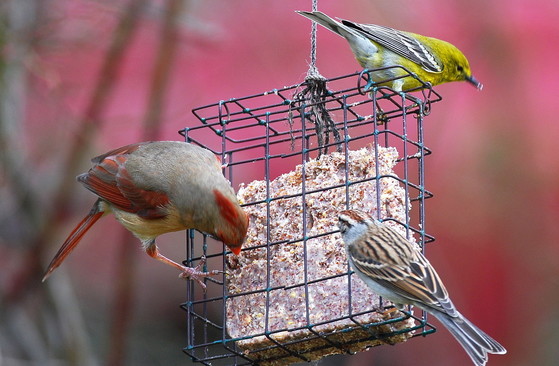 Birds and bird watchers favor suet (Terry W. Johnson)
By TERRY W. JOHNSON
Every time I go to the grocery store, I am reminded of the fact that we have more food choices than ever. For example, where there was once a single variety of Bush’s baked beans, now there are 13.
The same is true for suet and bird “puddings.” When suet first hit the market, you could only buy pure beef suet. And it was in a rectangular cake. Today, stores specializing in wild bird-related products sell suet in a variety of flavors and shapes.
What is also clear, however, is that this high-energy food is favored by many. More than half of the participants in Cornell University's FeederWatch Survey use suet, making it the third-ranked food offered. Thirty-two percent provide bird puddings.
Given the draw of these products to birds and bird watchers, here's a closer look. …
Read Terry’s column to sort out suet and puddings, and what to use in your yard.
Terry W. Johnson is a retired DNR program manager and executive director of TERN, the Wildlife Conservation Section’s friends group. Check out past columns, his Backyard Wildlife Connection blog and his book “A Journey of Discovery: Monroe County Outdoors.” His columns are also featured at DNR’s blog, under the Conservation tab. Permission is required to reprint a column.
Top
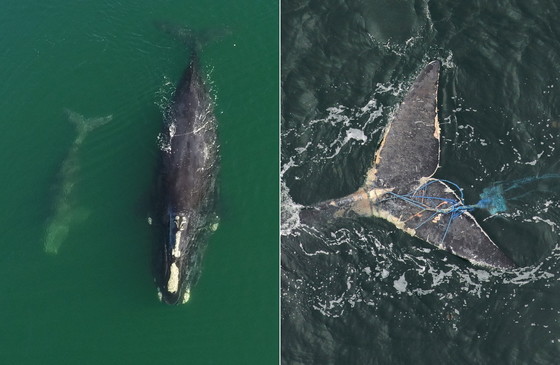 One of the 14 mom-calf pairs; (right) tail of whale tangled in fishing rope and part of a shellfish/fish trap (DNR/NOAA permit 20556; Clearwater Marine Aquarium Research Institute/NOAA permit 18786)
Thankfully, this calving season for North Atlantic right whales has been more Jekyll than Hyde.
As of Monday, 14 calves had been seen off the Georgia and northeast Florida coast, the only known calving grounds for these endangered whales. Researchers haven’t documented this many calves since 2016.
Even better, for four of the moms it was their first calf, 17 other adult females have been spotted – some of which might calve – and calving season lasts another month.
But January also included a grim reminder of the threats these gentle marine giants face. An adult male right whale was spotted offshore of the Georgia/Florida line with fishing rope wrapped around its tail and dragging part of what looked like a fish or lobster trap/pot. The entanglement is considered life-threatening.
With a Clearwater Marine Aquarium Research Institute survey team helping in a plane above, Georgia DNR tried on Jan. 11 and with a Florida Fish and Wildlife Conservation Commission crew the next day to attach a tracking buoy. They couldn’t. The whale’s evasive behavior, rough seas and the loss of light as evening set in undercut the effort both days.
The 33-year-old male cataloged as no. 1803 has not been seen since.
Entanglement in commercial fishing gear and vessel strikes are the two leading causes of right whale deaths. There are fewer than 375 North Atlantic right whales alive, according to the most recent estimate.
If 1803 is spotted, crews will try again to attach the tracking buoy and disentangle the whale.
For now, with seasonal surveys continuing, biologists hold out hope … for 1803 and for more calves.
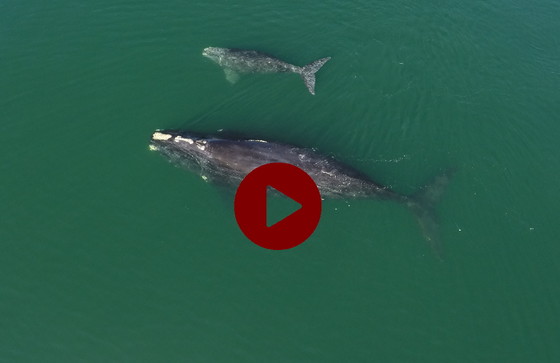 DID YOU SEE ...
This video of a mom and calf off Wassaw Island on Jan. 19? The mom, no. 3720, is 14 years old and this her first known calf.
WATCH OUT FOR CHAMPAGNE
NOAA is advising boaters and others in southeastern Florida to be on the lookout for right whale mom "Champagne" and her calf.
Both were spotted last week heading south near West Palm Beach, Fla.. Usually right whales give birth off the Georgia and northeast Florida coast, then migrate north to New England.
NOAA is asking any who see these or other right whales to give them space. Federal law requires that everyone and everything – from boats to drones and paddleboards – stay at least 500 yards away. Also report sightings to 1-877-WHALE-HELP (877-942-5343) to let biologists know so they can track the whales' movements.
Top
 From one perspective, fire is a destructive force. But from another, fire restores.
Many natural habitats in Georgia, and native wildlife such as gopher tortoises that depend on them, were shaped by regular sweeps of fire and require burns to survive.
DNR is in thick of “fire season,” when the agency teams with partner organizations and private landowners across the state to apply prescribed fire to restore and maintain fire-adapted habitats.
But what does restoration by fire look like?
Find out in this slideshow of prescribed fire impacts over the years at a site on Reed Bingham State Park near Adel and another at Hard Labor Creek State Park near Rutledge.
Also, here’s the classic time-lapse video by photographer Rich Reid of a burn and the forest's response at Moody Forest Wildlife Management Area near Baxley.
DID YOU KNOW ...
It's prescribed fire awareness week? Learn more at goodfires.org.
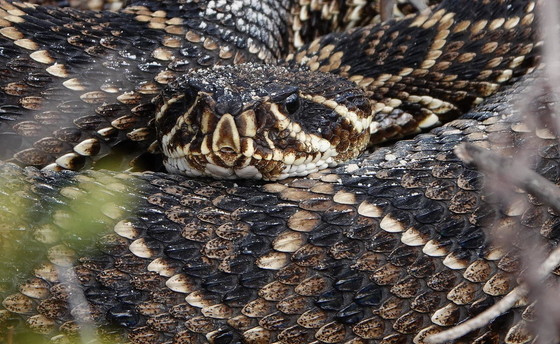 Eastern diamondback rattlesnake (Matt Moore/DNR)
SNAKES, FIRE AND LONGLEAF
A recently published study of snakes and fire frequency in longleaf pine ecosystems divides the reptiles into specialists – their distribution strongly overlaps with longleaf – and generalists, which are not exclusively associated with longleaf. Think eastern diamondbacks vs. gray ratsnakes.
Nine years of monitoring both groups at Jones Center at Ichauway revealed that “specialist” snakes tended to use forests burned within roughly one year, generalists waited longer – a year-and-a-half to three – and both avoided sites not burned within 10 years. These and other findings from the study could factor into managing longleaf forests for snakes. For more.
Top
 Ossabaw matriarch "Sandy" West makes a point while talking with DNR's Mark Dodd on the island. (DNR)
Georgia DNR joins the Ossabaw Island Foundation and many others in marking the passing and legacy of Eleanor “Sandy” Torrey West, the matriarch of Ossabaw. West died on Jan. 17, her 108th birthday. Her parents bought the island in 1924, and in 1978 West and her family sold it to Georgia, creating the state’s first heritage preserve, 26,000 acres of maritime forest, wetlands and beaches limited to “natural, scientific and cultural study, research and education, and environmentally sound preservation, conservation and management of the island’s ecosystems.”
Necropsies on 60 percent of the 100 sea turtles that stranded on Georgia’s coast last year showed that boat collisions accounted for about a third of the deaths. Loggerheads were the species that stranded most (38), followed by green sea turtles (30), Kemp’s ridleys (29) and leatherbacks (three), according to Ashley Raybould of DNR’s Wildlife Conservation Section. Forty-one turtles were captured incidentally; 26 were released or will be after rehabilitation. Stranding updates.
The Youth Birding Competition T-shirt Contest is open for entries. March 10 is the deadline to submit artwork. Other DNR outreach that helps youth learn about nature while creating art include the Georgia River of Words Poetry and Art Contest, the Georgia Fish Art Contest and the Give Wildlife a Chance Poster Contest.
Top
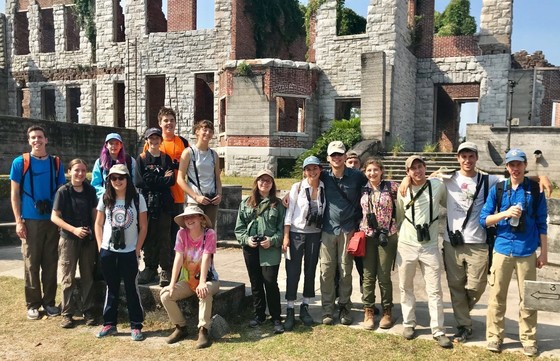 2019 Camp TALON crew on Cumberland Island (Julie Duncan)
Registration begins for the 2021 Camp TALON on Monday. The DNR camp, set for June 5-10 and open to teens ages 14-19, is a birding and ecological whirlwind that includes many of the Georgia coast’s top birding hotspots, from Harris Neck National Wildlife Refuge to Little St. Simons, Sapelo and Cumberland islands. Register before April 16 for a reduced fee.
It's time to sign up, too, for summer camps at Charlie Elliott Wildlife Center near Mansfield. The lineup features conservation fun and education for youth of all ages, from Charlie's Trackers for 6- to 8-year-olds to Wilderness Survival for ages 12-16.
Need more evidence that tegus in the wild are bad news? Salmonella can be prevalent in wild populations. New research probes the issue in Argentine black and white tegus on an archipelago off the coast of Brazil.
Track conservation-related bills in the General Assembly through updates from the Georgia Conservancy. Sign up for or read the Conservancy's take here.
Late-winter and early spring are great times to catch big fish in Georgia. DNR's Angler Awards Program recognizes anglers who land a trophy, and sports a youth category with lower weight requirements to recognize young anglers. Find a certified scale. Flip through the new fishing regulations.
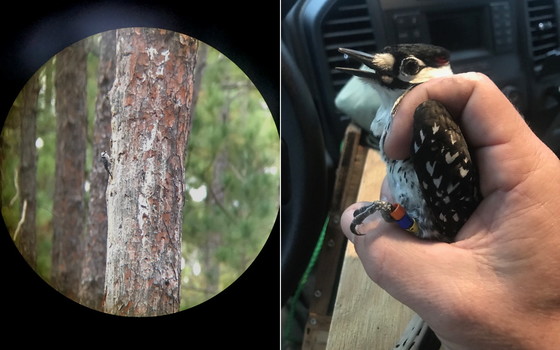 Red-cockaded woodpecker at Fort Stewart and in hand, bound for Moody Forest (Joe Burnam/DNR)
Add two red-cockaded woodpeckers to Moody Forest Wildlife Management Area. DNR’s Wildlife Conservation Section teamed with Fort Stewart and The Nature Conservancy staff to capture the young male and female at Fort Stewart and release them on the WMA near Baxley. The hope is they stay and form a breeding pair, becoming the ninth family group of the endangered birds at Moody Forest.
Names in the news: Covington resident Thom Litts is the new assistant director at DNR’s Wildlife Resources Division, of which the Wildlife Conservation Section is part. The 18-year employee was promoted from fisheries chief in December, filling the vacancy created by Ted Will’s appointment as director. The U.S. Forest Service’s Thomas Black recently earned a 2020 Bronze Smokey Bear Award, the highest honor for wildfire prevention service. Black, a firefighter on the Chattahoochee-Oconee National Forests’ Chattooga River Ranger District, received the award from Regional Forester Ken Arney and Forest Supervisor Edward Hunter in Gainesville. Doug Tallamy, author of Bringing Nature Home, is the speaker at this year’s Johnstone Lecture, set for 7 p.m. Wednesday and named for the State Botanical Garden of Georgia’s first director, Dr. Francis E. Johnstone Jr. In the virtual lecture (attendance is free), Tallamy will discuss things everyone can do to help reverse the decline in biodiversity.
WHAT YOU MISSED ...
In the previous Georgia Wild:
- Right whales: What you need to know
- Why weather loaches aren't welcome
- Winter survival and woodpecker cavities
Top
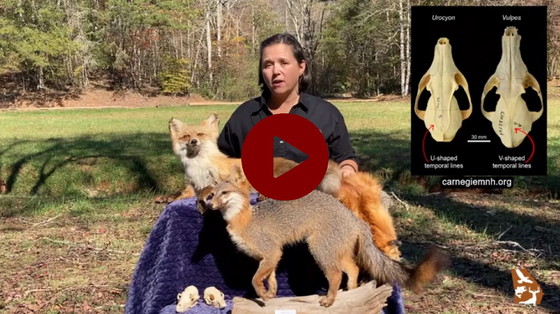 "Hey, Whaddaya Know? Gray Fox," DNR
"Surprise Duck Box Encounter," DNR
"Talking Nature Tuesday: Biodiversity," DNR
Georgia Farm Monitor (includes DNR "Talking Nature Tuesday: Invasive Exotics" at the 8:20-minute mark)
Top
(+video) "A woman and her island," WSAV-TV (Savannah Morning News)
"Outlook grim for entangled right whale," Georgia Public Broadcasting.
Other right whale coverage: "Calf no. 14" (WJXT-TV, Jacksonville, Fla.); "Entangled whale spotted off Georgia coast" (SaportaReport); "Lobstering banned in most Mass. waters until late spring," GBH Radio/NPR (Woods Hole, Mass.); "Students advocate for whales, create life-size model" (Savannah Morning News); "Protection efforts ramp up" (Vineyard Gazette, Edgartown, Mass.); "Clearwater Marine Aquarium expands surveys" (WFLA-TV, Tampa, Fla.); "Even slow-moving boats likely to kill whales" (The Guardian, citing this study); "Data from space could help protect whales" (Canadian Space Agency); "63 tons of 'ghost gear' retrieved" (CTV, Canada)
"Scientists need your help spotting monarchs this winter," HuffPost. Also: Georgia Public Broadcasting, Lakeside on Lanier, Reporter Newspapers.
"DNR charges Fla. man for bear poaching," WGXA-TV (Macon)
"IKEA buys 11,000 acres of Ga. forest to protect it," WRBC-TV (Chattanooga, Tenn.)
"Sturgeon tagged 14 years ago recaptured in Ga., double the size," The (Macon) Telegraph
"During pandemic, record visitation at state parks," WABE-FM (90.1, Atlanta)
Top
 DNR's John Damer and the lake sturgeon in 2015 (DNR)
The first lake sturgeon DNR netted in the Coosawattee River this year was a familiar fish. UGA researchers had captured and tagged the sturgeon in 2007, when it was 22 inches long and weighed barely more than a pound. Eight years later, DNR senior fisheries biologist John Damer found the same fish trapped in the old lock at Mayo Lock and Dam Park in Rome during a flood (above). Damer returned the fish to the Coosa River. Recently, staff again netted the sturgeon during sampling (below, with fisheries technician Matt Phillips). It was now 42 inches long and 13.4 pounds. The fish should continue to grow: In their remaining range, lake sturgeon can live 55 to 80 years and top 100 pounds.
 The sturgeon this year, held by DNR's Matt Phillips (DNR)
Learn how DNR is restoring these dinosaur-era fish to the Coosa system, and what to do you if you see or unintentionally hook one (lake sturgeon are protected).
CREDITS
Masthead: whale's tale entangled in fishing rope (Clearwater Marine Aquarium Research Institute/NOAA permit 18786)
Top
|